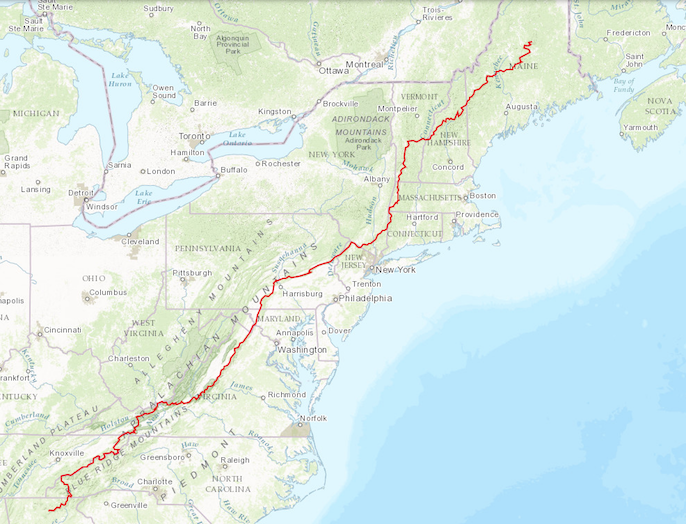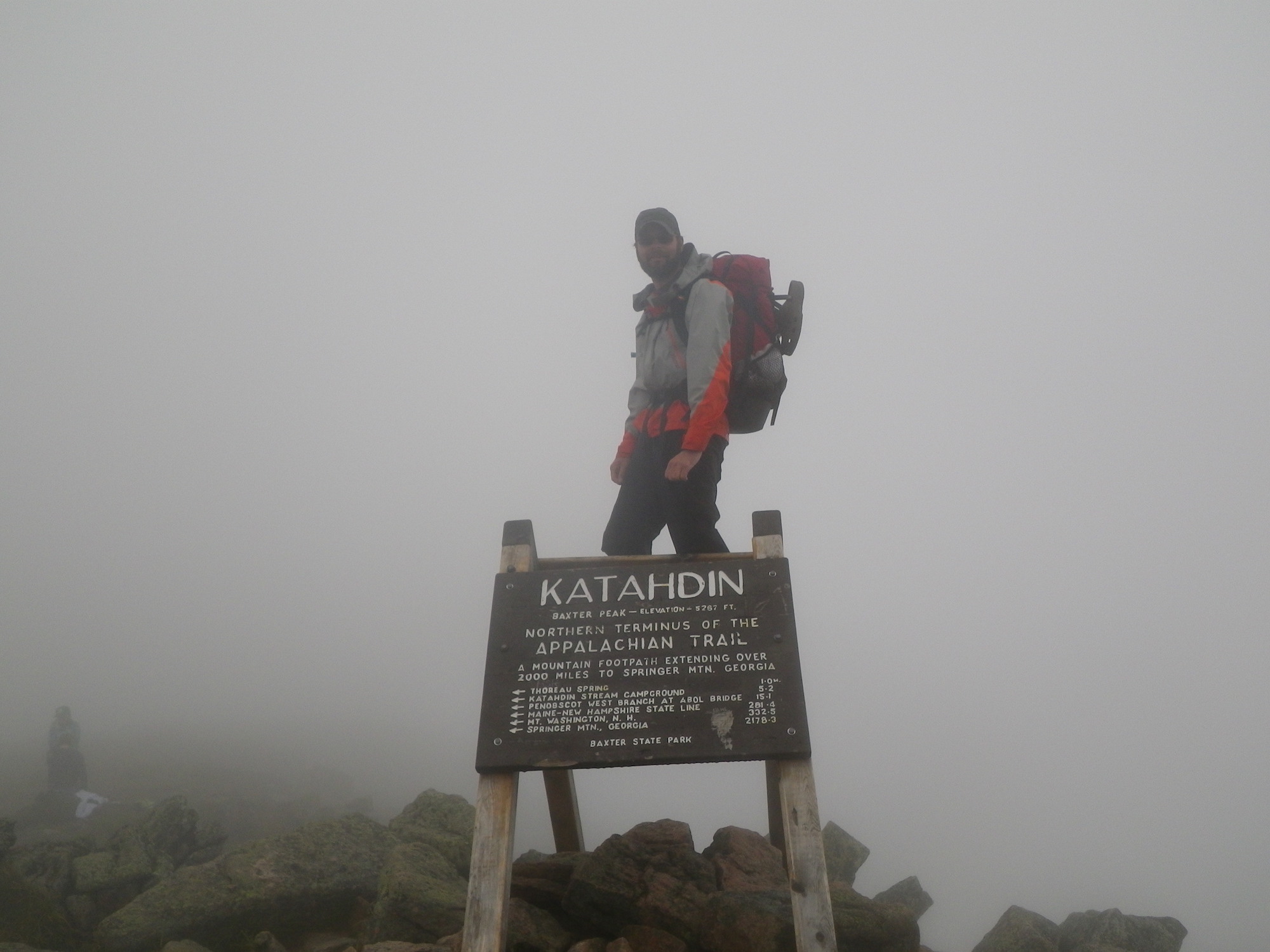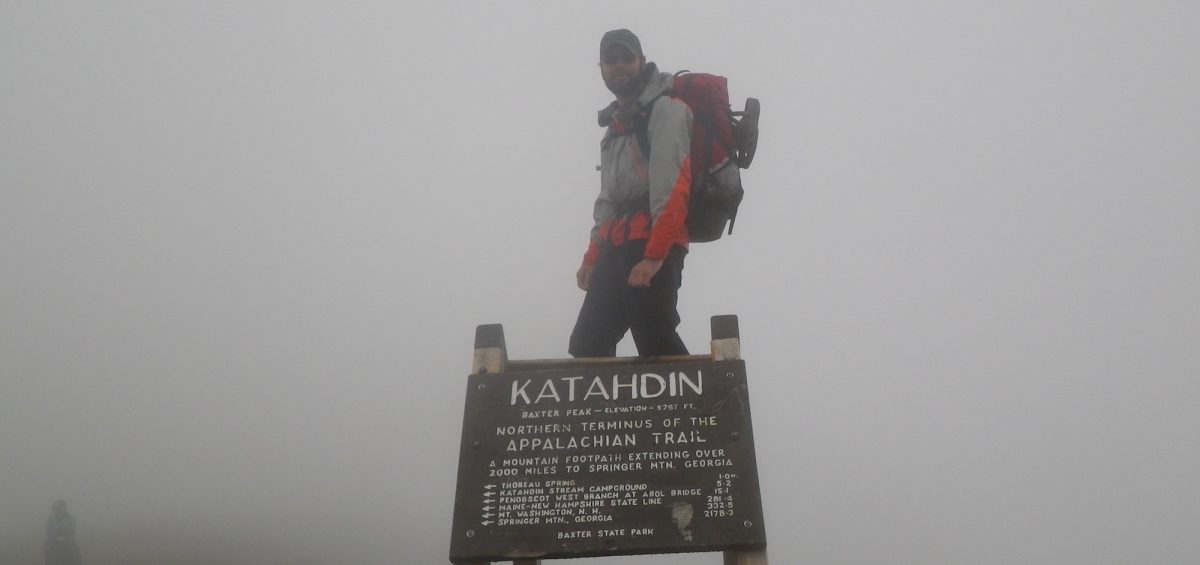Have you ever had those lifelong ambitions, those experiences or achievements that you hope to accomplish during your lifetime? Many call this a “bucket list”. One item on my list was to complete the entire Appalachian Trail (AT). That’s hiking 2,187 miles up the Eastern coast, which is called Thru-Hiking and is all about physical and mental strength.

I began my AT adventure on March 28, 2011 at the bottom of Springer Mountain in Georgia and finished at the peak of Katahdin Mountain in northern Maine on July, 28, 2011. During my four-month odyssey, I walked across fourteen states, took more than five million footsteps, wore out six pairs of boots and had the journey of a lifetime!
My passion for hiking was formulated at 10 years old when my parents took my brother and me backpacking one summer to the Delaware Water Gap on the Pennsylvania border.
The Delaware Water Gap is an area of the USA bordering the states of New Jersey and Pennsylvania where the Delaware River cuts through a large ridge of the Appalachian Mountains. This also happens to be a section of the great Appalachian Trail. I remember talking with thru hikers I met about their experiences on the trail and I was so fascinated that I lost track of the time. It surprised me that they carried their whole world on their backs and had already traveled so many miles. It’s about 1284 miles from the start of the trail in Georgia to where they were now in Delaware. I recall that these hikers thoroughly and seriously enjoyed their hard peppermint candy for dessert. A delicacy on the lower end of candies often frowned upon by schoolchildren. If you get one for Halloween you may have done something wrong. The fact that grown adults indulged in this treat is a testament to the humbling experience the trail can dish out.
When I started my trek, my backpack was heavy. Over 45 pounds! As I made my way through multiple states, my backpack became much lighter. I found out some things I just didn’t need. Life can be funny that way too. We accumulate so many things we forget why we got them in the first place. Towards the end of my adventure, my backpack weighed 24 pounds. This included one liter of water and four days of food. I wont say how many clean pairs of underwear remained.
Speaking of food, I can’t eat Clif Bars, protein bars, granola bars, Luna Bars, pretty much the only bar I can stand now is one that serves beer. I had so much of that stuff I started dreaming about it. Food became my “Kryptonite.” We burned so many calories a day and would eventually end up talking about what we could eat if we were anywhere near real food. You could tell thru hikers were really hungry when they would eat uncooked Ramen noodles dipped in peanut butter. But really, you cannot imagine how beautiful those Ramen Noodles look in the pale light of a full moon.
There was a gravitational pull to the towns along the AT, where we resupplied and recuperated. Towns are usually found at lower elevations meaning we would be walking downhill with our packs at their lightest because we were low on food. Then we’d “carb up”, on real food like pizza and spaghetti. Well, sort of real. The joys on arriving in town were warm showers, food, beer, ice cream and laundry. Another joy was when kind, local folk, known as “trail angels”, would give us a lift or drop off special treats for hikers.
And as you know for every action there is an equal and opposite reaction and that’s exactly what occurred when we left town. We lifted heavy packs after resupplying and lugged them back uphill to our campsite with one more great meal tucked inside.
Most hikers walk in synthetic fabrics because they dry fast. The downside of this material is that it traps body odor. I knew I smelled bad when I could smell the soap on the day hikers! It’s all a part of the magic of the hike!
Several au pairs have verbalized a version of this struggle:
“What does my life become when I return home?”

A month after completing my trip, during a routine physical, my doctor discovered that my cholesterol levels were high. When I told her that this seemed normal, she looked puzzled. She asked, “How could this be? You just walked 2,187 miles and burned 6,000 calories a day. You just mentioned that you discovered you were in good shape when you could consistently walk 30 miles a day 7 days a week. That is like doing more than a marathon every day with a weight on your back!”
I told her that on her way home from work to stop at a gas station and tell me what food she would choose to live on for the next five days. The food in small convenience stores, often in easy reach of hikers, is packed with crap that does not support a healthy cholesterol diet.
I have given multiple presentations about my experience on the AT. I often ask the audience what they believe might be the most problematic and dangerous animal on the trail. Time and time again, people mention bear, copperhead snakes or wild boars. They are often surprised when I state that deer ticks with Lyme disease are a major concern. There is also a microscopic parasite in our clear mountain water, which can cause giardiasis. This is popularly known as beaver fever and usually causes discomfort in he bowels. I used a hand pump water filter system to avoid this nasty disease. The filter does not make dirty water clean, but rather it makes unsafe water safe to drink.
Before I went on the AT I did a lot of daydreaming about what it would be like to actually be on the trail. Once I was on the trial, I started daydreaming about what I wanted to do when I actually got home. Why is it that we always want what we don’t have and take for granted what we do have?
One of the reasons I went on this long walk was to assess my past and prepare a game plan for my future. That did not happen. After many long miles I lost some of my mind chatter and something amazing happened. I learned to live in the moment and to absorb the present beauty that came with each step.
Often people ask me what the hardest part of the AT was. Most people are shocked when I tell them, “Coming off the trail, when you have reached your goal, I struggled with what life had to offer once your lifelong dream has been completed. I was not alone with this struggle! People who complete writing books, getting their PhDs, or become retired athletes who no longer have sport teams, all experience some form of this emotional drain.
Several Au Pairs have verbalized a version of this struggle. “What does my life become when I return home?”
The cure for post-dream fever is another story all together. Thru hiking the AT has and continues to change my life. I honestly believe that the true gifts in our human journeys are profound meaningful experiences, NOT the possession of special things!
– Mike S.


